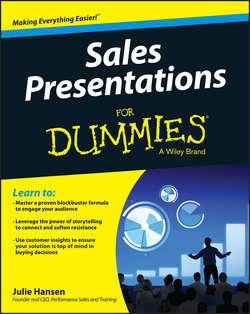Читать книгу Sales Presentations For Dummies - Julie M. Hansen - Страница 7
На сайте Литреса книга снята с продажи.
Part I
Getting Started with Sales Presentations
Chapter 1
Embracing the Future of Sales Presentations
Devoting the Necessary Preparation
ОглавлениеToo many great concepts fail to execute because of a lack of preparation. As a salesperson, you have to wear a lot of different hats – that of researcher, strategist, designer, and performer – which can cause you to feel stretched for time. But by applying some of these simple preparation strategies you can streamline your process and improve the impact and outcome of your presentation.
Creating dynamic presentation material
You probably have sat through your share of deadly PowerPoint presentations with their many bullet points, bouncing shapes, and dizzying animations. If slides are your medium of choice, get updated on contemporary design guidelines to keep your presentation from triggering nausea. Following are some key things to remember when planning your presentation material:
✔ Start with a concept. Most salespeople jump to create slides the minute they get the presentation on their calendar. Taking the time to stop and consider what you want to accomplish can save you from showing up with a PowerPoint collage of ideas and styles.
✔ Focus on one idea. The rule of “one slide – one idea” can keep your presentation clean, clear, and on point.
✔ Set the tone. Is it serious or light? Emotional or logical? The tone or feeling you want to create influences everything from your theme, your colors, your choice of pictures, and your fonts.
✔ Say it with a picture. A bold graphic can communicate an idea quicker than a slide full of text.
You can discover more helpful design tips in Chapter 9.
Using your performance tools
Like an actor, you’re auditioning for a role in your prospect’s business. To win the part, you need to do more than just memorize the lines. Most salespeople spend the vast majority of their time preparing the message and forget about the messenger. The following are your performance tools, and they’re a ready resource for enhancing and reinforcing your message:
✔ Your voice: As the delivery vehicle for your message, your voice holds a lot of power, yet few people use it to its full potential. Variety in volume, pacing, pausing, and emphasis can draw attention to key messages and make your content come to life.
✔ Your body: How you use your body – gestures, movement, eye contact, stance – sends a steady stream of information to your prospect. That information can say “I’m credible and confident and you should listen to me,” or “I wish I were anywhere but here!”
✔ Your stage: Your stage is your surroundings. How you move about your stage can renew flagging attention or be a source of distraction.
Refer to Chapter 11 for more about using your voice, body, and staging.
Leveraging the power of stories
Logic is great stuff and presentations are packed with it. But logic doesn’t engage your prospect on an emotional level – and most purchases are decided with emotion and justified with logic. Stories are powerful vehicles for triggering emotions, changing opinions, and creating memories.
You may be hesitant to use a story in your presentation because you’re concerned your prospect will get impatient. Of course, the real danger is if your story is too long, irrelevant, or trivial. In Chapter 12, you discover how to craft a purposeful story that addresses a specific need in your presentation and connects quickly and easily to your prospect’s goals.
